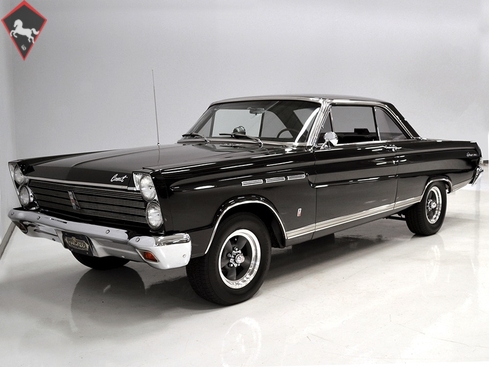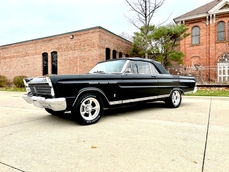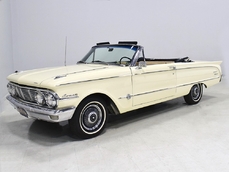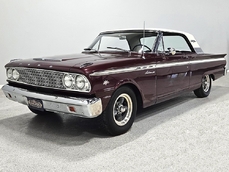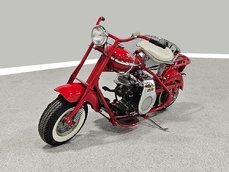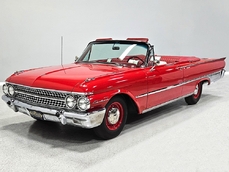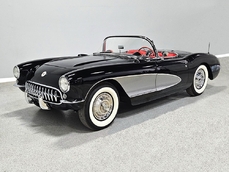Mercury Comet 302 cubic inch V8 1965
Allgemeine Beschreibung :
Everyone knows that the Mustang is actually a Falcon underneath, but did you know that this 1965 Mercury Comet Caliente is actually a Mustang Boss 302 underneath? Mercury’s upscale small car is suddenly a red-hot property in today’s market, perhaps owing to the fact that it’s got all the Mustang’s virtues, but it’s not a Mustang. Rarity matters after all. And thanks to an incredible rotisserie restoration that retains all the Comet’s sophsitcated good looks and adds a serious dose of modern performance to the mix. How does 385 horsepower from a Boss 302 V8, a 5-speed manual transmission, disc brakes, rack-and-pinion steering, and a gorgeous interior sound to you? Pretty amazing, right?
Built by a former Ford engineer up in Livonia, Michigan, this Comet is a take-no-prisoners combination of ‘60s sensibility and modern tech. The build reportedly cost more than $90,000 and one glance down the arrow-straight black flanks shows you where they spent a big chunk of that budget. I’m guessing that this car wasn’t this straight when it was new, never mind 52 years later. Gaps are exacting and the doors open and close with ease, suggesting a car that has never been abused or twisted. It appears to be 100% original sheetmetal, as well, including the quarters, floors, and trunk extensions, so while it was built in Michigan, it must have lived most of its life in warm, dry Atlanta, which is the DSO to which it was originally delivered. A bare-metal repaint ensures that everything underneath is just as good as you’d hope and the two-stage PPG urethane paint should last practically forever. Check out the dramatically sculpted bodywork that gives the Comet a wedge-shaped profile, the awesome stacked headlights, which were new for ’65, and the crisp yet subtle folds of the front fenders as they pull away from the headlight buckets. This was designed to be an affordable Mercury, but it sure looks expensive. All the original trim was retained in the build, including the wonderfully ornate grille, which consists of four groups of four thin strips of stainless trim, a theme that is echoed in the taillights and the trim pieces on the rear deck below the window. The stainless window surrounds were polished, and since you know there are no reproduction trim bits for these cars, things like the taillights, rocker trim, and bumpers are excellent.
The interior was originally light blue cloth, but during the restoration it was treated to all-new upholstery in basic black, which not only matches the bodywork, but gives it a formal look. That also means that everything that is black inside this car is new, including the correct door panels with vertical pleats, the carpets, and the awesome-looking seat covers. It’s probably worth mentioning that the weather seals are all new as well, so there are no rattles and no leaks at speed, making this feel like a new car as you drive down the road. I don’t know if the gorgeous woodgrained wheel is original equipment, but it looks spectacular, and if you’re a Mustang fan, you’ll probably recognize the gauge arrangement. However, only the speedometer is original-issue, with the auxiliary gauges being modern Auto Meter dials cleverly hidden in the original bezels so they’re a lot more accurate. There’s also a vintage Sun tach up high on the dash, right where Ol’ Shel put it in the GT350s. This was apparently a radio delete car, and the original block-off plate was just too cool to discard, so the modern AM/FM/CD stereo system was discreetly tucked under the dash to provide entertainment. That factory-style shifter looks industrial sticking out of the transmission tunnel, and if you look at the knob it now features five gears instead of three or four (actually, this car was originally an automatic). There are new seat belts, a new headliner, new dash pad, fresh woodgrain appliques, and on the rear package shelf, a pair of 6x9 speakers and a high-mounted stop light that makes sense when the original lights are low and covered with louvers. The trunk is beautifully finished with a correct mat with lots of sound-deadening material underneath, as well as a full-sized spare with cover and a relocated battery.
This car was indeed an original V8 car, coming from the factory with a 200-horsepower C-code 289, but in its place today you’ll find a Boss 302 crate motor from Ford Racing Performance Parts. Using the same 4-bolt main block as the legendary Boss, it’s built for combat and now grunts out a dyno-verified 385 horsepower. There are forged internals, a set of aluminum cylinder heads, and a very trick Tri-Power setup using three Holley 2-barrel carbs to really deliver some snap. It runs on the center carb most of the time, so it’s docile enough to drive every day, but push through the modest stop in the throttle and the outer carbs come online and the Boss throws the Comet forward like it’s been kicked. A Mallory Unilite electronic ignition system lights the fires and a set of gorgeous ceramic-coated long-tube headers feed a custom 2.5-inch stainless steel exhaust system with TIG welds that border on art. Flowmaster mufflers give it a great sound, but they’re big so it never gets annoying, and the tips are discreet turn downs just behind the rear bumper. It starts quickly and easily and there’s an electric pump for priming and high-performance use, but on the road, you don’t need it. A giant aluminum radiator ensures that it never gets hot or fussy and all the wiring, plumbing, lines, and hoses are new. And just take a moment to admire the engine bay, which uses finned valve covers, matching air cleaners, and a lot of polished stainless hardware to make a statement.
The aforementioned Tremec World Class 5-speed manual gearbox is a neat fit in the Comet, almost as if it was designed to be there. It’s linked by a heavy-duty clutch to a custom driveshaft and a rugged 8-inch rear end with 3.55 gears inside, so it’s plenty punchy around town but with the towering overdrive, it cruises at 2200 RPM at 70 MPH. The front suspension is stock, but the steering is now a Uni-Steer rack-and-pinion unit that is so effortless that power assist is completely unnecessary. Out back, new springs are assisted by adjustable Cal-Track traction bars that really do help nail down the power as well as a set of air shocks that allow you to adjust the ride height. Subframe connectors were welded into the tub to really reinforce it in a way that you can feel in the seat of your pants. Of course the floors are in excellent condition and have been treated to a light dusting of undercoating, but not so heavy as to hide the details—it’s just protection. SSBC front disc brakes were added to handle the added performance and all the lines underneath are stainless. And for just the right vintage performance look, traditional Torque Thrust wheels and staggered 215/70/14 front and 225/70/14 rear BFG radials add some rake.
We’ve never seen a nicer Comet than this, and given the way the last one had three guys fighting over it and ultimately sold for full asking price, we’re pretty sure this one won’t be around long, either. It’s just beautifully built, insanely fast yet very usable, and it’s just a well-thought-out machine. The fact that it’s also gorgeous and comfortable are merely icing on the cake. A Mustang built to this level would be crowding the $50,000 mark, but the Comet remains the affordable alternative, and we’re quite certain you’ll have a hard time finding a better one. Call today!
http://www.harwoodmotors.com/vehicles/inventory_details.php?id=739
1965 Mercury Comet 302 cubic inch V8 is listed verkauft on ClassicDigest in Macedonia by for $37900.
Fakten der Auto
Karosserietyp : Auto Marke : Mercury Modell : Comet Ausführung : 302 cubic inch V8 Hubraum : 0.0 Modelljahr : 1965 Lage : Ohio
Verkauft
Angaben Zum Verkäufer
Verkauft
People who viewed this Mercury Comet also viewed similar Mercury listed at ClassicDigest
Other cars listed for sale by this dealer
über Mercury
Mercury, die Automarke, hat eine reiche Geschichte, die über ihre Rolle in der Anpassungs- und Hot-Rodding-Szene hinausgeht, insbesondere mit dem ikonischen Mercury Eight. Hier sind einige wichtige Punkte über Mercury:Gründung und Frühe Jahre:
Mercury wurde 1938 von der Ford Motor Company als Mittelklassemarke eingeführt und positionierte sich zwischen den erschwinglichen Ford-Modellen und der Luxus-Lincoln-Reihe. Die Marke sollte die Lücke zwischen diesen beiden Segmenten füllen.
Mercury Eight:
Der Mercury Eight, eingeführt im Jahr 1939, ist vielleicht das bekannteste Modell in der Geschichte der Marke. Er zeichnete sich durch ein elegantes Design und einen leistungsstarken V8-Motor aus. Dieses Modell wurde für die Anpassung und das Hot-Rodding populär und hat einen bedeutenden Platz in der amerikanischen Automobilkultur eingenommen.
Kultur der Anpassung:
Der Mercury Eight mit seinem unverwechselbaren Design und einem relativ erschwinglichen Preis wurde zu einem Favoriten unter den Bauherren von maßgeschneiderten Autos. Er spielte eine entscheidende Rolle in der Entwicklung der Kultur der maßgeschneiderten Autos und Hot Rods, insbesondere in der Nachkriegszeit.
Lead Sleds und Anpassung:
Der Begriff "Lead Sled" wird oft mit stark angepassten Autos aus den 1940er und 1950er Jahren in Verbindung gebracht. Diese Autos, einschließlich des Mercury Eight, wurden oft mit tiefergelegten Aufhängungen, gekürzten Dächern und anderen stilistischen Veränderungen modifiziert. Lead Sleds waren ein herausragender Bestandteil der Kultur der maßgeschneiderten Autos, und der Mercury Eight war eine beliebte Wahl für solche Modifikationen.
Wohlstand der Nachkriegszeit:
In der Nachkriegszeit erlebte Mercury, wie viele andere amerikanische Automobilhersteller, einen Aufschwung der Popularität, als die Wirtschaft florierte. Die Marke trug zur Faszination für stilvolle und leistungsstarke Autos dieser Ära bei.
Entwicklung von Modellen:
Im Laufe der Jahre produzierte Mercury verschiedene Modelle und trug so zum Angebot von Ford bei. Einige bemerkenswerte Modelle sind der Mercury Monterey, der Mercury Comet und der Mercury Cougar.
Niedergang und Einstellung:
Trotz Phasen des Erfolgs hatte Mercury Schwierigkeiten, eine eindeutige Identität neben Ford zu etablieren. Mit dem Wandel der Verbraucherpräferenzen kämpfte die Marke, und Ford kündigte schließlich 2010 die Einstellung von Mercury an.
Erbe in der Populärkultur:
Mercury, insbesondere Modelle wie der Mercury Eight, nimmt einen bedeutenden Platz in der amerikanischen Populärkultur ein. Die Verbindung zur Szene der Anpassung und des Hot-Rodding sowie das unverwechselbare Design haben einen nachhaltigen Einfluss hinterlassen.
Zusammenfassend lässt sich sagen, dass der Mercury Eight für seine Rolle in der Kultur der Anpassung und des Hot-Rodding gefeiert wird, während Mercury als Marke eine breitere Rolle in der Automobilgeschichte spielte, indem sie zum mittelpreisigen Segment beitrug und die Automobil-Trends ihrer Zeit widerspiegelte.
